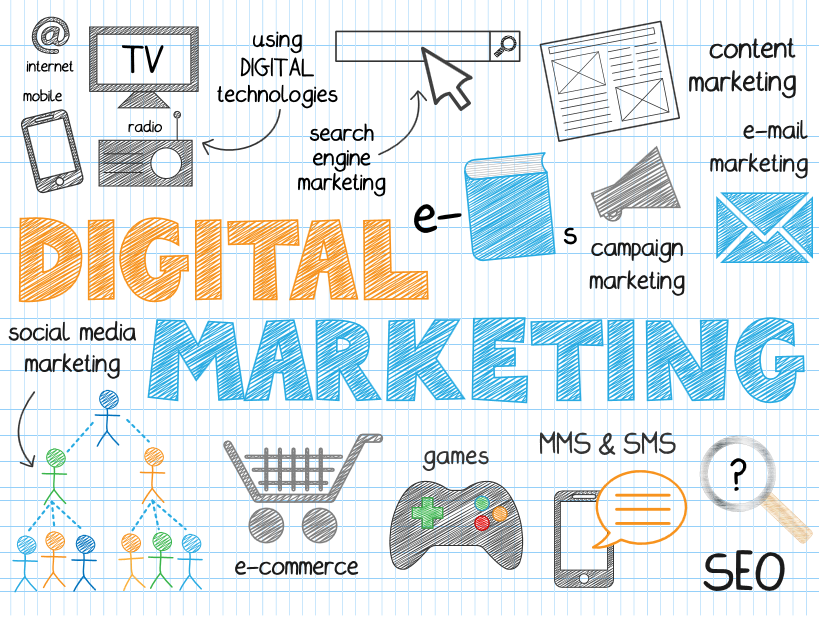Marketers know that digital marketing is the wave of the future, according to recent research:
- 75% say digital marketing has the highest ROI, according to Salesforce.
- More than 60% of marketing executives in a global study believe that digital marketing is more engaging that legacy media, according to Adobe.
- Digital marketing spend will surpass TV ad spend in 2017, according to eMarketer.
You can find stacks of statistics like this, but it’s not always clear just what they mean. The same studies show that while the numbers for faith in digital marketing are usually in the 60-75% range, satisfaction with their digital marketing strategies hovers in the 25-30% range, and some 80% of marketing executives say that they can’t find qualified people to do their digital marketing.
Whatever that means.
Here are just a few of the options brands have for digital marketing:
- Strong brand websites
- Content marketing
- Influencer marketing
- Social media marketing
- Pay per click advertising
- Online press and public relations
- Video marketing
And have you considered Snapchat or YikYak?
Broadly speaking, any marketing strategies and tactics that show up in digital media, whether on a smartphone or a desktop or a store aisle kiosk, can be called digital marketing. But just as your brand wouldn’t randomly choose between classified ads in the local Pennysaver paper and a halftime TV spot, your brand shouldn’t randomly choose between Instagram and Adwords.
Start with a strategy.
Who is your best customer and where does he or she hang out in the digital world? If your best customer is a 28 year old guy who uses his phone for everything, your answer will be different from the organization whose best customers is a female elementary school teacher from 30 to 50 who shops every day during her lunch break from her classroom desktop computer.
What do you want your customers to do? If you want them to book an appointment on your website, you need a different approach from the company that wants customers to provide email addresses for future marketing efforts or the one that wants customers to go buy their product in a physical store.
This is why you can’t just accept statements like, “Pinterest is the best traffic driver” or “85% of new leads come through paid search.
You have to begin with clear business goals, align them with digital marketing goals, and build a strategy based on that information.
Choose your tactics.
You have myriad choice in digital marketing, and unless your resources are unlimited, you can’t do all of them well. Identify the platforms and actions that will give you the best return on investment and focus on them.
Making these decisions requires more than a gut feeling that all the cool kids are using Instagram or that mobile virtual reality ads are the coming thing. Make some hypotheses based on what you know about your customers and their path to purchase, and run some tests. Based on the data you gain from those tests, plan a campaign or a series of campaigns and commit to your plan for five or six months.
Choose your digital marketing partner.
It makes sense to work with a digital marketing firm to create these campaigns. Their experience will help you get specific ideas and plans in play.
But remember the old saying that every problem looks like a nail to the person who only owns a hammer. If you go to an influencer marketing company, you will walk out with an influencer marketing campaign. If you go with a company that specializes in digital media buys, you’ll get ads.
You should also make sure that the company you choose can understand your business goals and identify the right digital marketing tactics to get you to those goals. We don’t think that means you should just nod when they say they’re going to activate influencers andleverage real-time data mining for thought leadership. If you don’t understand what they’re talking about well enough to be able to make decisions about their recommendations, they probably don’t have the expertise you need.
Track your results.
One of the great advantages digital marketing has over legacy media is the ability to track responses. You don’t know whether anyone read that classified ad in the newspaper before it hit the recycle bin, but you know how many people clicked on your Facebook link. You don’t know how many of those people went to a store to buy your product, but you have much more insight into customer behavior than you could ever get with broadcast or print.
Take advantage of that added information to fine-tune your tactics and your strategy, and you’ll see better ROI. When you’re ready to create a digital marketing strategy, contact us.


Leave a Reply